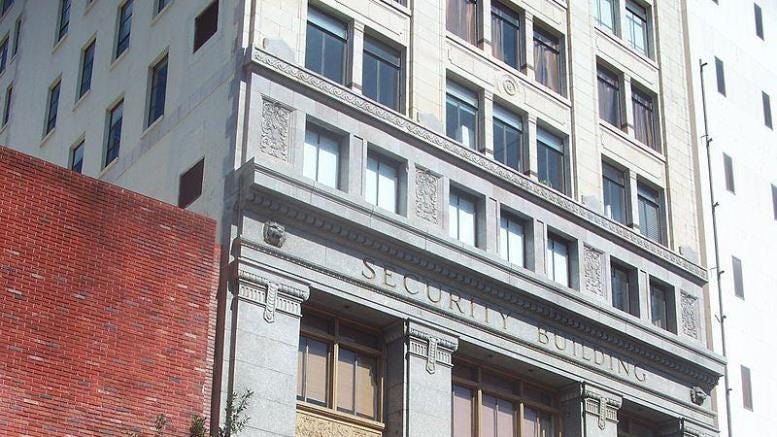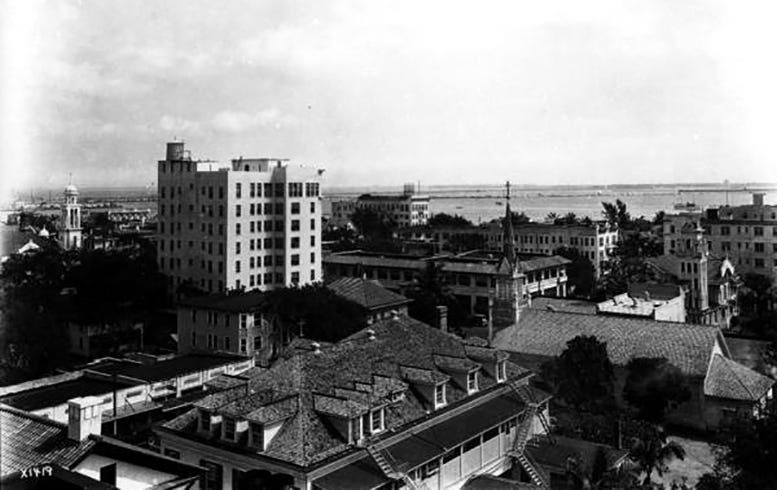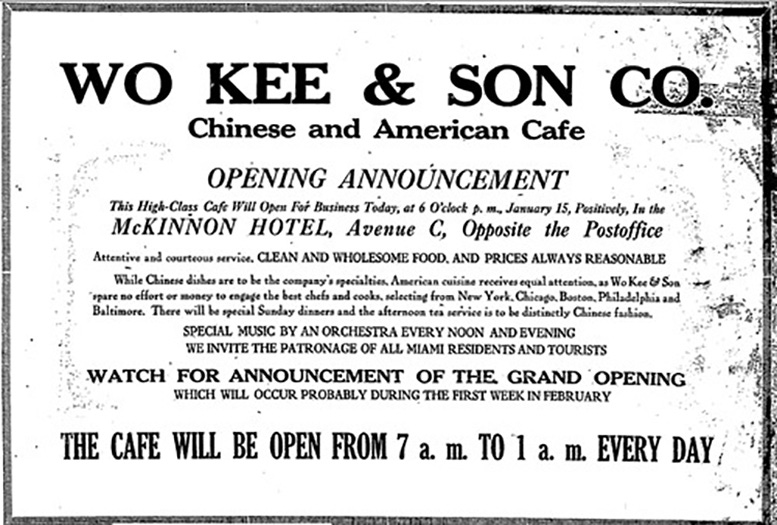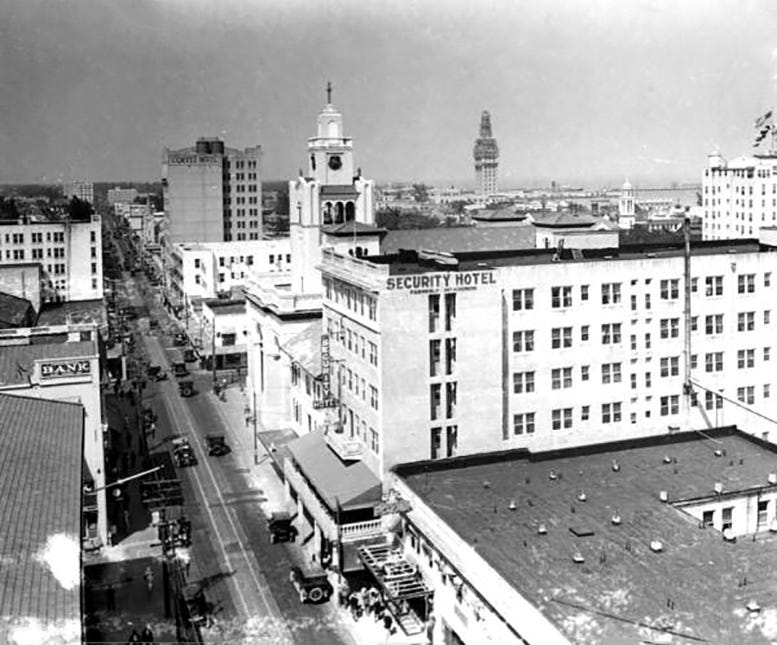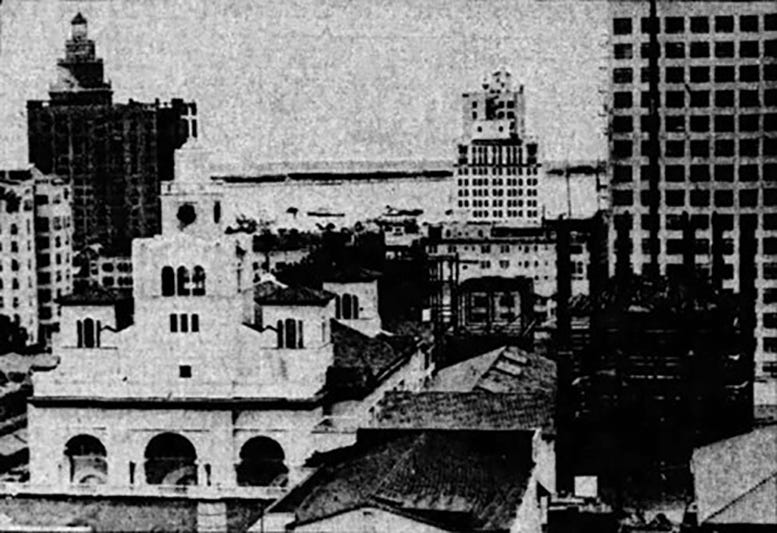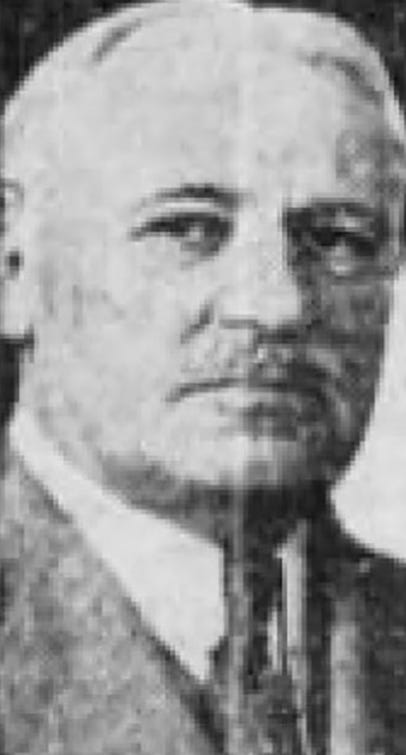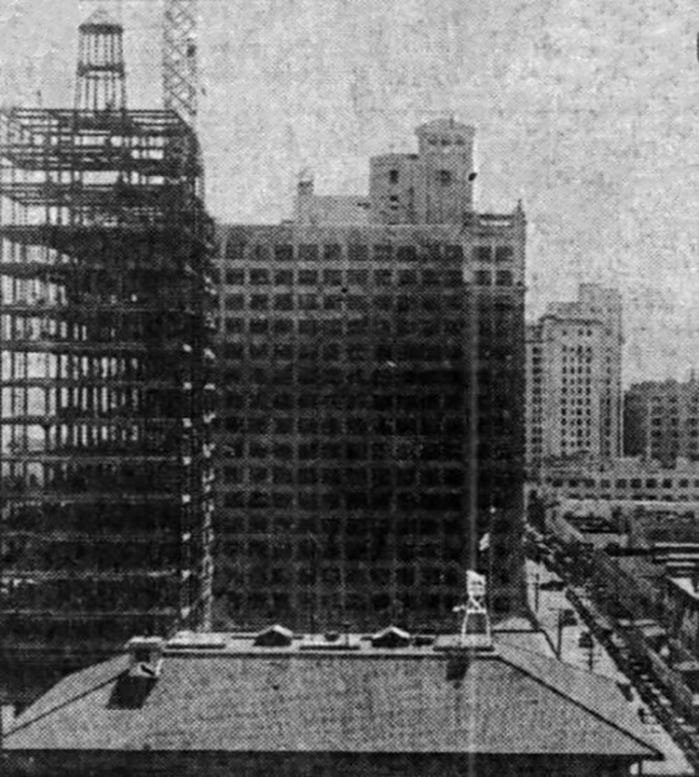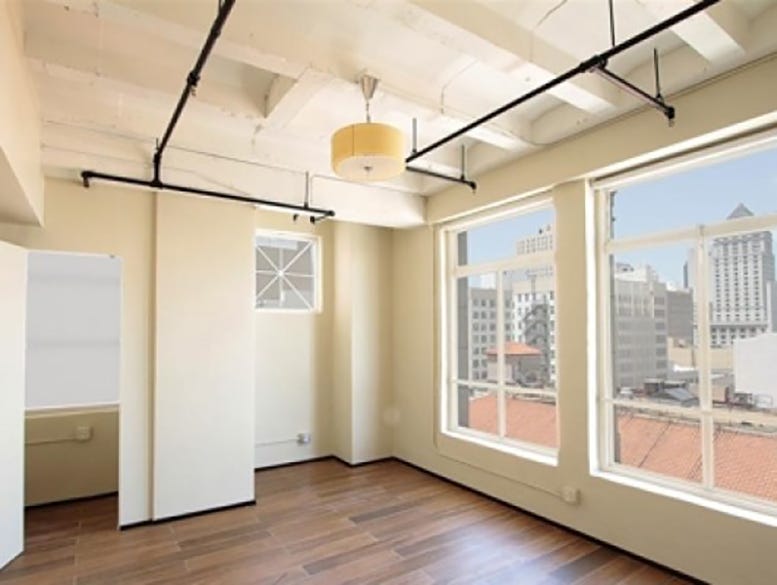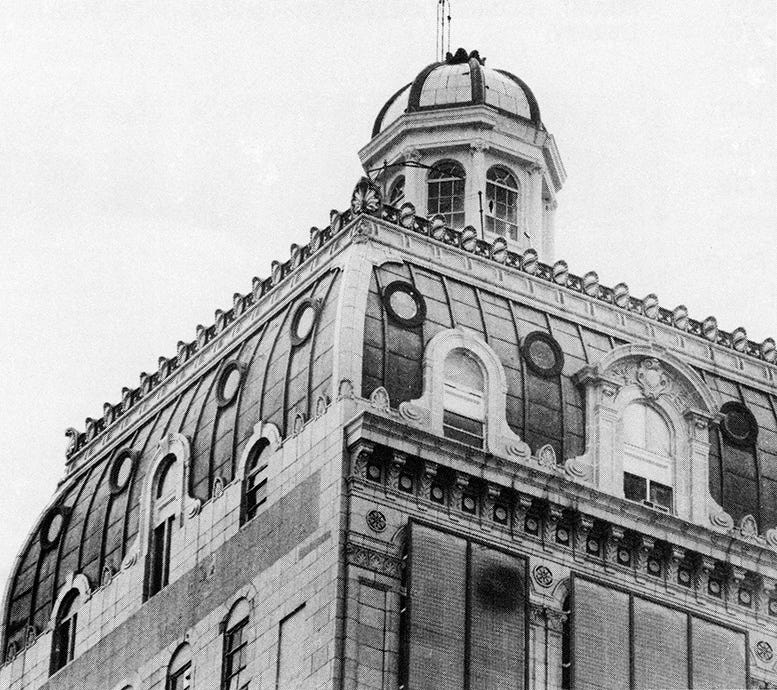Security Building in Downtown Miami
The full history of the Security building at 117 NE First Avenue in downtown Miami, Florida.
Since its opening, the Security Building has seen more than its share of change. While the building’s name and tenants have changed many times through the years, its architecture and history remind us of a special time in Miami’s past.
Built in 1926 as the corporate office building to one of Miami’s most important financial institutions, the Security Building represented “security” to early Miami homeowners and developers. However, the building bust of the 1920s changed the fate of both the company and building. While the commercial operation eventually went out of business, the building began a cycle of frequent change in ownership and tenant. It still stands in downtown Miami as a symbol of resiliency and a reminder of how much Miami has evolved since the structure’s construction.
McKinnon Hotel
Even prior to the great building boom of the mid-1920s, Miami experienced a shortage of accommodations for the large influx of visitors and new residents. By the 1910s, the requests for new building permits grew quickly, especially for new hotels and apartment buildings following the end of World War I. Most of these new permit requests were for buildings to be constructed in downtown Miami.
One of the projects that was started in 1919 was the McKinnon Hotel, a building that was centered on the east side of Avenue C, between Tenth and Eleventh Streets, based on the old street name system. After the institution of the Chaille Plan in 1920, the address of the hotel became 117 NE First Avenue, which is the current address of the building that replaced the hotel in 1925.
Costing $140,000 to build, the hotel was seven stories in height, and it opened in January of 1920. As soon as it opened, Wo Kee & Son announced a new Chinese and American café to open in the lobby of the hotel, which provided guests with a dining option within the building.
The McKinnon Hotel was the first building in Miami to create a basement that extended beyond the footprint of the foundation and terminated southward along the northern sidewalk on NE First Street. The idea was to allow access for efficient delivery of supplies and pick up of garbage from NE First Street to avoid cluttering NE First Avenue for such purposes. The plan called for a sidewalk elevator and a plate glass cover that was strong enough to sustain the weight associated with delivery and pickup. However, there was a concern about whether a basement could be sealed to ensure that it was waterproof. A Miami Herald article dated June 1, 1919, stated that “the consensus was that it could be done, just as successfully here as it was in Chicago”.
McKinnon Sold to Dade County Security Co.
The hotel operated as the McKinnon for less than two years when it was sold to the Dade County Security Corporation (shortened to Dade Security), in October of 1921. Founded in 1901, Dade Security was a building and loan company, whose officers consisted of pioneer business leaders in Miami, such as J.E. Lummus and Josiah Chaille.
The company was one of the most significant financial concerns in Miami during the first three decades of the twentieth century. In 1923, Dade Security financed the construction of over one thousand homes in the Miami area. Its business of funding construction projects and mortgages would prove problematic after the collapse of the building boom in the mid-1920s.
After the sale of the McKinnon, it was renamed to the Security Hotel to convey that “security and safety” were primary concerns for the new ownership entity. Dade Security also invested to upgrade the two-year old hotel as they remodeled the lobby and the second level.
Hotel Razed for Office Building
During the height of the building boom in the 1920s, the demand for office space out paced the supply by a wide margin. Knowing that the foundation of the hotel could accommodate several additional floors, Dade Security considered adding three stories to the existing hotel building and then converting it to an office building. Ultimately, the company opted to raze the existing structure and replace it with a new building.
In early September of 1925, Dade Security formerly announced their intention to knock down the hotel and replace it with a sixteen-story office tower. They gave their commercial tenants until September 20th to vacate the property. Following the vacancy date, Florida Wrecking Company demolished and cleared the six-year old hotel.
Once the hotel was cleared, the replacement building was given the name of the ‘Security Building’. The structure was built on a lot that has frontage of fifty feet on NE First Avenue and a depth of one hundred and fifty feet. The construction of the new building plus furnishings was budgeted to cost one million dollars in 1925. Dade Security turned to an architect with an impeccable reputation to design the building.
Architect Robert Greenfield
Shortly after being hired by Dade Security, Robert Greenfield made plans to travel to Miami to begin working on the design. However, when he was scheduled to leave from New York to Miami in February of 1926, he was delayed by a snowstorm confirming his decision to spend the winter of 1926 in a warmer climate. In an article in the Miami Herald on February 7th, Greenfield proclaimed “I am all for sunny Miami”.
Greenfield learned the trade of architecture in New York City as he served several years overseeing projects for the New York Board of Education. He later supervised the construction of the New York City Customs House and Assay House, while also adding the design of prominent edifices located in Philadelphia, Lansing Michigan and Pittsburgh to his deep resume.
While his first project in Miami was the Security Building, it was not his last. Robert Greenfield designed fine residences, apartments, schools and churches in Miami. His work included the Buena Vista School, the Randall Hill apartments and the Allapattah Methodist chapel.
Design & Construction of Building
The design of the building was described differently depending on the writer of the review. An article in the Miami Herald in November of 1926 described the style as “French Renaissance” while another article referred to the style as “Grecian architecture”. The mansard roof was considered a signature element of the Second Empire style, which was popular during the second half of the nineteenth century.
However, as described in the historic designation report filed in 2003, the style between the three-story base and the roof most closely resembles the design characteristics of the Chicago School. The design was named for the technological advancements that enabled the construction of high rise buildings in Chicago during the last quarter of the nineteenth century.
The interior of the building was just as exquisite as its exterior. The lobby stretched across the western front of the building and included chandeliers that hung from the second floor. Marble stairways with copper handrails were located on both the north and the south ends of the lobby, providing access from the ground to the second level, which overlooked the lobby.
The building is 166 feet in height, and included an outside façade comprised of ornamental granite to the top floor. Dade Security entrusted Fred T. Ley and company to implement Greenfield’s design as the general contract. Greenfield was so proud of his first project in Miami that he moved his office into the Security Building when it opened and agreed to manage it on behalf of Dade Security.
When it opened in January of 1927, the building provided for 275 offices and a set of four high speed elevators providing access to all floors. The entire first level was occupied by the Dade County Security Company.
All those involved with the project were very proud of the Security Building. In a Miami Herald article in May of 1927, architect Robert Greenfield took exception to a report by George Bennett, of the Pittsburgh Testing Laboratory, who stated the Dade County Courthouse was the best constructed building in the south. Greenfield declared the “Security Building as second to none” with design and construction that adhered to the highest standard of excellence. In his view, the Security Building was perfect. He felt that his accomplishment should be considered the best built building in the south.
Dade Security Files for Bankruptcy
With the abrupt end to the building boom just prior to the opening of the Security Building, the flagship tenant began to feel the economic downturn shortly after moving into their new headquarters. The large number of defaults on construction loans and mortgages quickly took its toll on Dade Security. By February of 1928, the company was opted to file for bankruptcy. While operating under receivership, the officers never found a way to reverse their financial hardship.
The company continued to limp along after the stock market crash of 1929 and then through the height of the great depression. However, by mid-1935, the company was forced to liquidate.
The sale of the mortgages preceded the sale of Dade Security’s two biggest assets: The Security and Congress buildings. The two buildings were sold at auction in September of 1940 for $480,150 to banker and real estate investor, T.T. Scott of Jacksonville, Florida.
Pan American Bank Building
In December of 1945, the newly formed Pan American Bank became the anchor tenant in the Security Building. T.T. Scott was one of the organizers of the institution and it was only natural that the bank began operating out of a building that he owned. The building was given the name of “Pan American Bank Building” and it kept that name for seven years until the bank decided to move across town. The bank purchased land on the corner of SE Third Avenue and SE First Street in 1951, and they announced their plans to move into a building built on that lot. Once Pan American Bank vacated, the building was renamed back to the Security Building on September 1, 1952.
Shortly after Pan American Bank moved across town, Scott formed another financial institution in June of 1953 called the Metropolitan Bank of Miami. The new bank moved into the ground floor of 117 NE First Avenue and became the flagship tenant of the Security Building.
Building Sold to Arthur Vining Davis
On April 2, 1956, Arthur Vining Davis purchased the Security Building from T.T. Scott for $850,000. In a separate transaction, Davis also purchased the Bedford Building, which was also located on NE First Avenue. The change in ownership led to a change in the name of the Security Building to the Metropolitan Bank Building on April 1, 1957.
The Metropolitan Bank of Miami was acquired by Capital National Bank in the summer of 1962, prompting another change in the name of the building. From 1964 until 2015, the building was referred to as the Capital Bank Building or just the Capital Building.
Two Buildings Traded for an Island
By the late 1960s, the Capital Bank Building was owned by Edwin Gage of Pontiac, Michigan. Gage also owned the Langford Building at the time. In August of 1969, as part of an unorthodox real estate transaction, Gage traded both buildings for 135-acre island near Fort Myers, Florida, called Lover’s Key.
The terms of the transaction gave French both the Capital Bank and Langford buildings, and, in turn, Gage acquired Lover’s Key. Gage’s plan was to build a community of apartments and single-family homes on the island.
Peoples Downtown National Bank
Leonard Usina was transferred to Miami by Ed Ball when he was Vice President of the Du Pont owned Florida National Bank and Trust in 1932. He left Florida National to start his own bank in 1950 and he named it the Peoples Bank of Miami Shores. Over time, he expanded and organized several bank branches under the name of the People’s National Bank Group.
In April of 1972, Usina’s bank group announced the acquisition of a majority share of the Capital National Bank and he renamed the bank Peoples Downtown National bank because he wanted to focus on lending to rebuild downtown Miami. Usina said that his intent was to lend money for construction of new buildings, or rehabilitation of old buildings, to revitalize the downtown area. He wanted to promote the construction of reasonably priced apartment buildings to bring people back to living in downtown Miami.
Usina lived in a penthouse at the Four Ambassadors in the Brickell neighborhood from the time the complex opened in 1968 and he was a big advocate of both living and working in a downtown setting. His personal philosophy was “you can find most of the things you need downtown”. In the early 1970s, he was one of the few that was promoting the return to the urban core.
In his first year running the bank branch, Usina turned a money loser into a profitable company. At the end of 1972, the bank showed a profit of more than $28,000 compared with a loss of more than $400,000 in 1971. The loss occurred prior to Usina taking over management of the downtown location.
Pan American & NCNB Acquire Peoples Bank
For the next ten years, Usina had operated a profitable banking entity. However, he was slowed by a bone disease in 1981. In October of 1981, Leonard Usina passed away at the age of 92. A month after Usina’s death, Pan American bank tendered an offer to purchase seven branches of the Peoples Bank Group in November of 1981. What made the acquisition complicated was that Usina, nor any other shareholder, had more than a five percent ownership interest in the bank.
Despite the complication, an agreement was made by Pan American Bank to acquire a majority share in the bank and most of the Peoples Bank branches. The acquiring organization was primarily interested in obtaining People’s strategic locations. They noted the importance of operating in Miami Shores and the Sunshine Industrial Park in North Dade. The downtown branch was not part of the acquisition.
In September of 1982, NCNB from Charlotte, North Carolina, purchased the only branch of People’s Downtown National Bank. The acquisition provided NCNB a charter to operate in South Florida. The bank had plans to expand into the Latin American market and felt they were best positioned to do so from downtown Miami.
Historic Designation & Capital Lofts
Through the remainder of the 1980s and 1990s, the Capital Bank Building continued to have a bank as its primary tenant. The Universal National Bank was the building’s primary tenant in the late 1980s and 1990s. In addition to the bank, the building also featured the Jewelry Center which was a group of wholesalers who manufactured, repaired and sold jewelry to retailers like Mayors, Burdines and Luria’s.
In March of 2003, the Capital Building was identified as part of a historic district in downtown Miami. The City of Miami Historic and Environmental Preservation Board filed for local designation for the building. The Security Building’s application was approved in 2003 and given the associated protections that go along with historic designation. While the exterior cannot be demolished or materially altered, a new owner in the early 2000s had plans to reconfigure the interior of the building.
Haim Einhorn proposed the Capital Lofts project where he would custom configure an office loft for prospective buyers. The project began converting floors in the building to office condominiums beginning in 2004, but the office condo market vanished after the 2008 financial collapse. The financial crisis left the Capital Lofts project in limbo and it was eventually sold to a different group.
WeWork Leases Security Building
On June 30, 2015, the Capital Building was sold for $23.5 million. The following October, WeWork agreed to lease the entire building. The company provides shared workspace, community and office services for startups and freelancers. WeWork has reverted to the building’s original name when referring to their downtown Miami location. It opened in January of 2018 and has been leased to near capacity.
The Security Building provides an excellent example of how an old building can be appreciated for its architecture and history, but also remain a functional member of the downtown building landscape. The Security Building is a case study on how other buildings in downtown Miami could be evaluated when it comes to preservation and adaptive reuse. There are plenty of great historic buildings in the downtown area that deserve similar consideration.
Resources:
Book: “Miami and Dade County Florida”, E.V. Blackman.
Report: “Security Building Designation Report”, March 18, 2003.
Miami Herald: “Builders of McKinnon Hotel to Construct Under Sidewalk Basement, First in Miami”, June 1, 1919.
Miami Herald: “McKinnon Now Security Hotel”, October 7, 1921.
Miami Herald: “Hotel Will Be Razed”, September 17, 1925.
Miami Herald: “Building Ready January 1”, November 6, 1926.
Miami Herald: “Perfection Claimed by Security Building”, May 18, 1927.
Miami Herald: “Bankruptcy Action Fails in US Court”, February 9, 1928.
Miami Herald: “Security Company Condition is Subject”, March 15, 1933.
Miami Herald: “Sale of Congress, Security Buildings Ok’d”, September 27, 1940.
Miami Herald: “Again It Will Be Security Building”, July 28,1952.
Miami Herald: “Tentative Ok Given to Bank”, June 14, 1953.
Miami Herald: “Davis Planning 2 Skyscrapers”, March 31, 1956.
Miami Herald: “2 Landmarks Here Traded for Island”, August 6, 1969.
Miami Herald: “Purchase of Bank Planned”, April 14, 1972.
Miami Herald: “New Owners Produce Turnaround at Money Losing Bank”, April 20, 1973.
Miami Herald: “Offer is Made to Acquire People Bank”, November 6, 1981.
Miami Herald: “Developers Offer Custom Fit on Condos”, March 10, 2003.
Miami Herald: “Miami Landmarks Up For Protective Designation”, March 18, 2003.
Miami Herald: “Investors Bet on Historic Downtown Condo”, April 1, 2014.
Miami Herald: “Security Building Sold in Downtown Miami for $23.5M”, July 30, 2015.
Images:
Cover: Security Building on NE First Avenue. Courtesy of the Miami Herald.
Figure 1: View looking southeast from McKinnon Hotel. Courtesy of Florida Memory. Photographer was William A. Fishbaugh.
Figure 2: Ad for Wo Kee & Son cafe in 1920. Courtesy of the Miami Herald.
Figure 3: Security Hotel in 1925. Courtesy of Florida Memory. Photographer was Richard B. Hoit.
Figure 4: Security Building lot next to Gesu Church. Courtesy of Miami News.
Figure 5: Robert Greenfield. Courtesy of the Pittsburgh Press.
Figure 6: Security Building under construction in August of 1928. Courtesy of Miami News.
Figure 7: Postcard of branch of Peoples National Bank in 1950s.
Figure 8: Interior of Capital Lofts in 2008. Courtesy of Cervera Real Estate.
Figure 9: Security Building in 2015. Courtesy of the Miami Herald.


